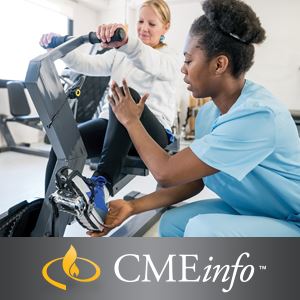
NYU Comprehensive Review of Physical Medicine and Rehabilitation 2019 (Videos)
$15.00
Format: 43 Video Files (.mp4 format) + 2 PDF files
Category: CME Videos Physical Therapy Videos/Audios
published date: 08 Feb 20

$15.00
Format: 43 Video Files (.mp4 format) + 2 PDF files
Category: CME Videos Physical Therapy Videos/Audios
published date: 08 Feb 20
Description:
Stay Current with the Latest Key Advances
NYU Comprehensive Review of Physical Medicine and Rehabilitation is an extensive review of clinically relevant topics in physical medicine and rehabilitation. This expertly designed CME course includes case-based lectures on topics like pathological gait, orthotics, upper limb prosthetics, cardiac rehabilitation, osteoporosis, entrapment syndromes, and more. It will help you to better:
Integrate evidence-based techniques for performing electrodiagnostic tests into practice
Diagnose and manage sports-related concussion in athletes
Demonstrate expertise in treating spasticity with botulinum toxin or intrathecal baclofen
Incorporate evidence-based clinical guidelines for diagnosis and treatment of musculoskeletal disorders
Assess capabilities and limitations of musculoskeletal ultrasound for diagnostic, interventional procedures
Expand Your Skills
Available online or via audio MP3 CDs, NYU Comprehensive Review of Physical Medicine and Rehabilitation provides a maximum of 36 AMA PRA Category 1 Credits ™ and access to unbiased, evidence-based content and case-based reviews so you can expand your knowledge and incorporate the latest guidelines into your daily practice.
Accreditation Statement
The NYU School of Medicine is accredited by the Accreditation Council for Continuing Medical Education (ACCME) to provide continuing medical education for physicians.
Credit Designation Statement
The NYU School of Medicine designates this enduring material for a maximum of 36 AMA PRA Category 1 Credits ™. Physicians should claim only the credit commensurate with the extent of their participation in the activity.
CME credit is awarded upon successful completion of the post-test and evaluation.
Date of Original Release: May 31, 2019
Date Credits Expire: May 30, 2022
Learning Objectives
At the conclusion of this CME activity, you will be better able to:
Incorporate evidence-based techniques for performing electrodiagnostic tests into practice
Incorporate a diagnostic strategy for traumatic brain injury, based on awareness of high incidence, and apply traditional physiatric care regarding traumatic brain injury for assessment and treatment of the concussed athlete
Demonstrate knowledge of diagnosis and management of the concussed athlete
Demonstrate correct injection and implanting techniques when treating spasticity management with botulinum toxin or use of an intrathecal baclofen (ITB) pump
Incorporate best evidence-based clinical guidelines for diagnosis and treatment of musculoskeletal disorders and evaluate limitations and capabilities of musculoskeletal ultrasound for diagnostic and interventional procedures
Incorporate the regulatory changes in PM&R and options for MOC lecture and discussion
Intended Audience
This course is intended for general physiatrists, physiatric subspecialists, family practitioners, internists, neurologists, orthopedists, pediatricians, rheumatologists, nurse practitioners, and physicians-in-training.
Topics/Speaker:
Normal Gait – Joan E. Edelstein, MA, PT, FISPO
Lower Extremity Amputation: Early Management – Edwin F. Richter, MD
Lower Limb Prosthetics – Joan E. Edelstein, MA, PT, FISPO
Pathological Gait – Joan E. Edelstein, MA, PT, FISPO
Upper Limb Prosthetics – Heikki Uustal, MD
Orthotics – Heikki Uustal, MD
Energy Expenditure and Gait Deviations During Prosthetic Ambulation – Jeffrey M. Cohen, MD
Traumatic Brain Injury: Epidemiology, Classification, and Early Management – Steven R. Flanagan, MD
Pharmacological Treatment of Traumatic Brain Injury – Steven R. Flanagan, MD
Rehabilitation of Patients with Stroke – Ira G. Rashbaum, MD
Rehabilitation of Children: Spina Bifida and Cerebral Palsy – Joan T. Gold, MD
Dysphagia – Stamatela Balou, PhD
Treatment of Spasticity – Heidi N. Fusco, MD
Cancer Rehabilitation – Jonas M. Sokolof, DO
Pharmacological Management of Pain – M. Fahad Khan, MD for Steven Calvino, MD
Interventional Pain Procedures: Indication, Complications and Technical Aspects – Kristoffer Padjen, MD, PhD
Osteoporosis – Valerie H. Peck, MD
Rehabilitation After Total Joint Arthroplasty – Ran R. Schwarzkopf, MD
Total Joint Replacement Rehabilitation: A Value-Based Management Approach – Jeffrey S. Fine, MD
Rehabilitation of Patients with Multiple Sclerosis – Jai S. Perumal, MD
Cardiac Rehabilitation – Jonathan H. Whiteson, MD
Pulmonary Rehabilitation – Jonathan H. Whiteson, MD
Classification and Epidemiology of Traumatic Spinal Cord Injury – Jeffrey C. Berliner, DO
Outcomes Following Traumatic Spinal Cord Injury – Thomas Bryce, MD
Rehabilitation of Patients with Burns – Robin B. Silver, BS, OT
Geriatric Rehabilitation – Cathy Cruise, MD
Principles in Hand Rehabilitation – Francis J. Lopez, MD, MPH
Maintenance of Certification Process and Performances – Randall L. Braddom, MD
Regulatory Challenges in PM&R and Health Care – Randall L. Braddom, MD
Arthritis: Diagnosis and Medical Management – Bruce M. Solitar, MD
Magnetic Resonance Imaging of the Degenerative Lumbar Spine – Gina A. Ciavarra, MD
Complex Regional Pain Syndrome – Jeffrey M. Cohen, MD
Industrial Medicine Cumulative Trauma Disorders – Sheila E. Horn, DO
Sports Injuries: Management and Exercise Prescription – Elizabeth Barchi, MD
Sports Concussion in Athletes – Brian S. Im, MD
Physical Modalities – Randall L. Braddom, MD
Physiology of Exercise for Strength – Randall L. Braddom, MD
Management of Cervical Pain Syndrome – Randall L. Braddom, MD
Management of Lumbar Spine Pain Syndromes – Randall L. Braddom, MD
Peripheral Polyneuropathies – Kiril Kiprovski, MD
Evoked Potentials – Aleksandar Beric, MD
Carpal Tunnel Syndrome – Aleksandar Beric, MD
Entrapment Syndromes – Jay M. Weiss, MD, FAAPMR, FAANEM